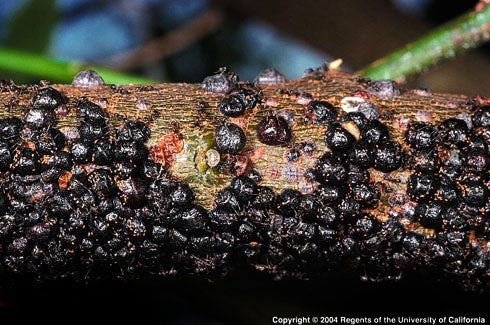Black Olive Scale, Saissetia oleae
The Situation: In California, black olive scale is a periodic pest of citrus in southern California and a consistent pest of olives in the San Joaquin Valley. It was introduced into the United States and California sometime before 1880. It now occurs in many regions of the world and infests a wide range of plants. Black olive scale is thought to be native to Africa. Until its natural enemy Metaphycus helvolus was introduced from South Africa (1937), black scale was a severe pest of citrus in southern California. Although widely established, this natural enemy does not suppress black scale on a consistent basis.
Damage: In the coastal valleys of southern California, black scale has a single annual generation, whereas in coastal southern California, it has two generations a year. On olives in the San Joaquin Valley, black scale has a single annual generation but does not infest citrus in this area. Black scale infests leaves when it is young but moves to the young branches when older. It sucks the sap from leaves and branches and produces a sugary exudate that drips onto leaves and fruit. At moderate scale densities, scale exudate supports fungal growth (sooty mold) which downgrades fruit in the packinghouse. At higher densities, scale populations decrease fruit size and substantially decrease fruit production the following season.
Economic Impact: Citrus is one of the 10 most important agricultural crops in California, with an annual value of $700-$900 million. The San Joaquin Valley produces about 65% of the citrus grown in the state. This percentage will increase as more of the citrus in the inland coastal valleys is eliminated by urbanization. Olives are an important California-grown crop, and black scale is a major pest on this commodity too. Control can usually be achieved with insecticide treatments.
Distribution: Black scale is mainly a pest of citrus in coastal and inland southern California and of olives in the San Joaquin Valley. It occurs at low levels on citrus in the San Joaquin Valley but is rarely an economic problem. In the low desert, black scale is occasionally treated with insecticide.
Research: The University of California at Riverside is developing an integrated pest management program that seeks to: (1) reduce the costs and improve the efficiency of mass-producing the natural enemy, Metaphycus helvolus that attacks black scale in California; (2) develop a cost-effective program that utilizes the mass-release of Metaphycus helvolus and another scale parasitoid M. sp. nr. flavus; (3) discover other effective natural enemies from the pest's native home; and (4) controlling Argentine ants, which feed off the honeydew produced by black scales but protect soft scale pests from their natural enemies.
More Media on Black Scale
UCIMP Online: How to Mange Pests: Black Scale
GardeningKnowHow.com: How to control plant scale
Center for Invasive Species Research, University of California Riverside
Text and provided by Robert F. Luck , updated by Mark Hoddle
Photos courtesy of Regents of University of California
Robert Luck, Professor of Entomology
robert.luck@ucr.edu
Mark Hoddle, Extension Specialist and Director of Center for Invasive Species Research
mark.hoddle@ucr.edu
Personal Website



